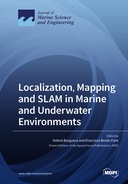Explore

Localization, Mapping and SLAM in Marine and Underwater Environments
0 Ungluers have
Faved this Work
Login to Fave
The use of robots in marine and underwater applications is growing rapidly. These applications share the common requirement of modeling the environment and estimating the robots’ pose. Although there are several mapping, SLAM, target detection and localization methods, marine and underwater environments have several challenging characteristics, such as poor visibility, water currents, communication issues, sonar inaccuracies or unstructured environments, that have to be considered. The purpose of this Special Issue is to present the current research trends in the topics of underwater localization, mapping, SLAM, and target detection and localization. To this end, we have collected seven articles from leading researchers in the field, and present the different approaches and methods currently being investigated to improve the performance of underwater robots.
This book is included in DOAB.
Why read this book? Have your say.
You must be logged in to comment.
Rights Information
Are you the author or publisher of this work? If so, you can claim it as yours by registering as an Unglue.it rights holder.Downloads
This work has been downloaded 83 times via unglue.it ebook links.
- 83 - pdf (CC BY) at Unglue.it.
Keywords
- 3D vision
- acoustic image segmentation
- array errors
- autonomous navigation
- Channel Model
- Computer vision
- deep learning
- electric field
- History of engineering & technology
- image global signatures
- inspection and maintenance
- interference-plus-noise covariance matrix
- meta-EP PSO
- multi robot
- Neural Network
- passive detection
- pipe and valve recognition
- point cloud segmentation
- range sensing
- robust adaptive beamforming
- signal denoising
- signal enhancement
- Simultaneous Localization and Mapping
- sonar
- steering vector mismatch
- subspace scanning
- Technology, engineering, agriculture
- Technology: general issues
- underwater acoustic signal processing
- underwater localization
- underwater perception
- underwater robotics
- visual loop closure
Links
DOI: 10.3390/books978-3-0365-5498-3Editions

